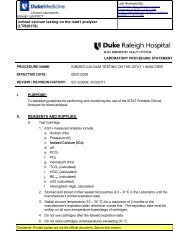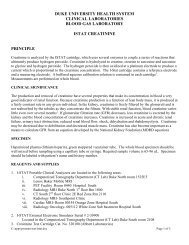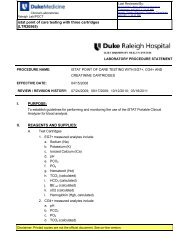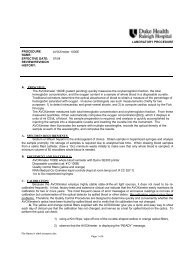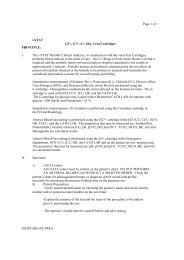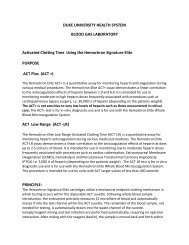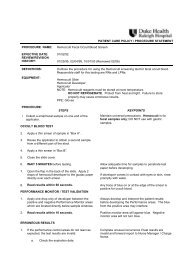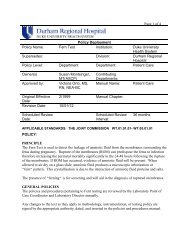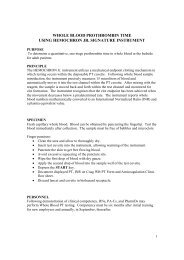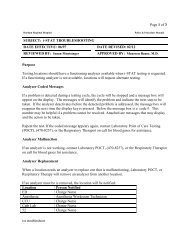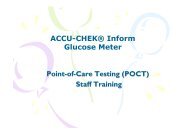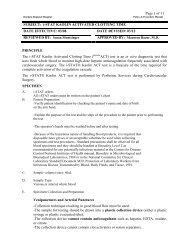Nitrazine Paper - Point of Care Testing - Duke University
Nitrazine Paper - Point of Care Testing - Duke University
Nitrazine Paper - Point of Care Testing - Duke University
You also want an ePaper? Increase the reach of your titles
YUMPU automatically turns print PDFs into web optimized ePapers that Google loves.
Page 2 <strong>of</strong> 3<br />
<strong>Nitrazine</strong> pH analysis must be ordered by the patient’s physician.<br />
PATIENT IDENTIFICATION:<br />
Verify patient identification by checking the patient's name and date <strong>of</strong> birth on the arm band.<br />
PATIENT PREPARATION:<br />
Explain the purpose <strong>of</strong> the test and the steps <strong>of</strong> the procedure to the patient prior to performing<br />
the test.<br />
The operator’s hands must be washed before and after testing.<br />
Because <strong>of</strong> the hazardous nature <strong>of</strong> handling specimens contaminated with blood and body<br />
fluids, it is required that disposable latex gloves or an acceptable substitute be used when<br />
collecting specimens and test procedures. Standard precautions shall be observed for all<br />
specimens contaminated with blood and body fluid and they should be handled at Biosafety<br />
Level 2 as recommended for any potentially infectious material in the Centers for Disease<br />
Control/National Institutes <strong>of</strong> Health manual, Biosafety in Microbiological and Biomedical<br />
Laboratories, 1988 or in the National Committee for Clinical Laboratory Standard Document<br />
M29, Protection <strong>of</strong> Laboratory Workers from Infectious Disease Transmitted by Blood, Body<br />
Fluids, and Tissue, 1991.<br />
SUPPLIES: Gloves<br />
<strong>Nitrazine</strong> paper<br />
<strong>Nitrazine</strong> pH Quality Control buffers<br />
STORAGE:<br />
It is recommended that the <strong>Nitrazine</strong> pH paper be stored securely in its holder in a dry place at room<br />
temperature. <strong>Nitrazine</strong> pH papers expire on the date printed on the foil wrapper.<br />
QUALITY CONTROL:<br />
1. <strong>Nitrazine</strong> pH paper test strips should be tested when opening a new container and at least<br />
weekly using <strong>Nitrazine</strong> pH buffer controls, 5.0 and 7.0.<br />
2. Check the expiration date <strong>of</strong> the <strong>Nitrazine</strong> pH paper.<br />
3. Check the pH <strong>of</strong> each buffer; 5.0 and 7.0. Record the results on the <strong>Nitrazine</strong> pH QC Log.<br />
4. Note any failures on the <strong>Nitrazine</strong> pH QC Log. Retest; if failure again, obtain a new box <strong>of</strong><br />
<strong>Nitrazine</strong> pH paper and /or buffer(s) and follow steps= 1-4. Document corrective action<br />
taken on the QC Log.<br />
PROCEDURE:<br />
1. Explain procedure to woman/couple.<br />
2. Ensure that the fluid is appropriate for <strong>Nitrazine</strong> pH testing. Do not use for urine or gastric<br />
pH.<br />
3. Check the expiration date <strong>of</strong> the <strong>Nitrazine</strong> pH paper.<br />
4. Remove 3-4 inches <strong>of</strong> <strong>Nitrazine</strong> pH paper from container. With gloved hand, insert<br />
<strong>Nitrazine</strong> pH paper into the introitus <strong>of</strong> the vagina. Remove hand and paper.




